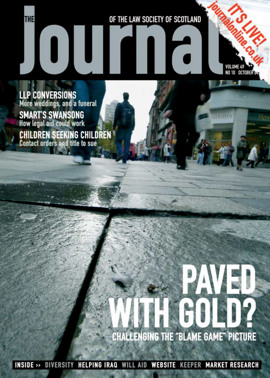Walk this way?

With the "Right to Roam" legislation in England and Wales, and the "Access Rights" legislation in Scotland, the public has finally secured a statutory right to enjoy the countryside.
The access rights conferred on the public in Scotland are very much more extensive than those conferred in England and Wales. There, certain land has been designated as land to which the public has access. Here all land is subject to access rights, unless specifically excluded. To talk of access to the countryside is, in fact, misleading. The Land Reform (Scotland) Act applies equally to towns, although the public debate did not really pay much attention to that.
This is a radical development, and it is surprising that it did not provoke a more vigorous reaction from landowning and land management interests. The fact that it did not was perhaps due to political realism, a gradually more tolerant attitude to public access to the countryside, and an uncertainty as to the existing law of trespass.
Does the Act go too far, in favouring the rights of the public to the detriment of the rights of the individual?
The Act recognises that the public has a legitimate stake in the land (and this includes inland water and canals) which are parallel to the rights of those who own, or work the land. These are, however, different rights in the land and the Act tries to ensure that these parallel rights operate in harmony.
But don’t interfere
The rights of the public are not unrestrained and the restraint takes three forms.
The first is the exclusion of access rights from certain lands.
Health and safety factors, and security, exclude such places as factories and storage areas, chemical and processing plants, water treatment and sewage works, building sites and quarries, and similarly with railways and airports. In order to protect schoolchildren, schools and school fields are excluded, and so is MOD land where access is prohibited in the national interest. Nothing for the individual to be concerned about here.
In towns, golf and bowling greens, cricket squares and tennis courts and the like are excluded, but playing fields are excluded only when there is a game in progress which would be interfered with. (Don't move behind the bowler's arm!)
There is, naturally, an exclusion for houses and an area of garden or other land as will give the residents reasonable privacy and freedom from disturbance in their enjoyment of the house. This is likely to be contentious until the courts clarify what this means. The alternative attempts at a definition, however, either gave inadequate protection in all instances, or else would have excluded many acres of ground in other cases.
Particularly important are the exclusion of farm steadings, and land with growing crops. Farmers, however, will have to consider whether there is likely to be pressure for access through any of their arable fields. If so an end rig, or perhaps a head rig should be left unsown, for access over crops growing on them is permitted. The exclusion of farmsteads is a very real concession to the farming community considering that that is often the natural way to take access.
It is in this sort of situation that existing and new rights of way (whose position the Act strengthens) will continue to be important means of passage to the land beyond.
The second restraint is the exclusion of certain conduct. One may not have a dog that is not under control, nor hunt, shoot or fish, nor use a motorised vehicle (other than a disabled one) or motorised vessel (so no jet skis). One may enter a golf course only to cross it. In recognition of the issue of security, access rights do not apply where a person intends to commit an offence.
Finally, access rights must be exercised responsibly, so as not to cause unreasonable interference with the rights of others and in accordance with the guidance contained in the Outdoor Access Code.
Responsibility rewarded
For the first time, detailed advice on how persons should conduct themselves has been set out, and this should inform those unfamiliar with the ways of the countryside on how they should behave. Plant and animal life are all mentioned. If a study of the code is incorporated in the school curriculum then people will be aware of what is required of them.
The Act places an obligation on those who manage land to do so in ways that are conducive to access. As one would expect, local authorities can remove misleading and intimidating notices, but now a positive attitude is required. Bodies such as the Forestry Commission are in the process of adapting their standard procedures, and enlightened land managers have shown the way to the more recalcitrant.
In Scotland there has been a long tradition of good relations between the majority of those heading for the hills and the majority of those who own and work the land. The Scottish Executive was persuaded to introduce this radical legislation because of the responsible behaviour of the public during the outbreak of foot and mouth. If that continues then those who view the access provisions with disquiet, should have their fears allayed.
George Menzies is Chairman of Scotways and a former partner in Turcan Connell
In this issue
- Citizenship, society and solicitors
- The well unfair state
- Litigation nation
- Best medicine
- Take a deep breath
- What title?
- Walk this way?
- Know your strategy
- e-quilibrium?
- The researchers
- Rights out of anarchy
- Political correctness or positive change?
- Steering clear
- How far can a board go?
- Major role for new tribunal
- The race is on (again)
- Planning a superhighway
- Website reviews
- Book reviews
- Single survey's lonely heart
- In harmony
- Clearing the path






